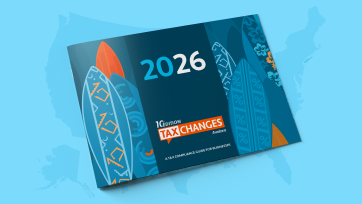
Seeing clearly through the tax complexities of diverse service bundling
Peanut butter on pickles. French fries dipped in milkshakes. Ranch dressing on pizza (sacrilege!). Culinary adventurers have dared to couple foods that traditionally have no business touching each other, let alone entering your mouth at the same time. But experiment they have, and many of those innovations have gone mainstream — like bacon-flavored vodka.
Similar ingenuities have started to propagate in the business world. Companies are pairing disparate services into combo packages for consumers. One of the most prominent examples is communications providers that pull streaming services into their bundled offerings. In the past, cell phone packages typically included no more than talk, text, and data. But now, when you sign up with T-Mobile, you can get access to Hulu, Netflix, and Amazon. Verizon offers the same trio, plus several additional options.
And it’s not just communications and streaming services sharing the bundling love. Many industries are broadening their bundling, like the fitness, automotive, and ride-share sectors. Consumer Cellular is pairing up with the ride-sharing company Lyft. Previously, the transportation service was limited to smartphone users via the Lyft app. Now, any Consumer Cellular customer — including those who only have landlines or flip phones — can access the ride-share services.
Free for a fee
Another additive to nontraditional services pairings is that some businesses advertise these bundled extras as “free.” Rarely is that the case. Somewhere, somehow the customer pays for the add-on service in a less obvious manner — the cost is often just part of the package price, but the company lumps the charges into one grand total.
Tax entanglements
Though the diverse options look good to the consumer, how do businesses address the inevitable eclectic smorgasbord of tax liabilities? How will the odd new combos be taxed? Some of these services don’t present the same tax obligations or associated regulations.
Communications tax is different than regular ol’ sales tax. Sales tax is typically based on a straightforward rate, though it’s not without its own complexities.
Communications tax, on the other hand, involves a motley bag of taxes and fees ensnared in copious regulations set at the federal, state, and local levels. When businesses then patchwork extraneous services into one package, they can spawn a new level of convolution. No longer are they working within the known tax confines of their own industries.
Streaming taxes are relatively new and harbor myriad fees — public utility, regulatory, etc. However, some companies that offer these services don’t realize they’re on the hook for communications taxes. But the burden is always on the organization to know its tax obligations and properly file.
Knowing your tax liabilities is a tricky, continuous endeavor with ever-evolving changes in state and local regulations and definitions. Several states have redefined communications tax eligibility, and others are on their way. Every state has its own take on communications and video taxes. For example, streaming providers are liable for utility and communications tax in lieu of sales tax in some locations. Other states tax content downloads but not streaming subscriptions, and yet others do the reverse.
And of course, as we mentioned, taxes get even more complicated when you have a jumble of services in your bundle and can go in different directions depending on whether you offer the service as over the top (OTT) or as a network provider.
Tax authorities in Iowa announced Amazon’s video streaming services meet their definition of “pay TV” and therefore are subject to its associated taxes. But in Iowa, if one service is declared taxable, then the whole bundle becomes tax eligible. With that, Prime memberships in Iowa were obligated for sales and use tax just because of the Prime Video component. Similar fates can befall cell phone providers that offer streaming services as part of a bundle.
You never know what alterations or regulations state and local governments will spring on companies as industries, technologies, and business models evolve.
Here are four strategies to help organizations plan for and address fluid and complex taxes that may lurk in disparate services bundles.
1. Monitor tax forecasts
Tax rules and regulations can change like the weather. Closely track all jurisdictions across your service areas. This may require extra resources, including automated software to help keep abreast of changes, but it will be well worth the effort to avoid detrimental audits and other repercussions. Tax authorities expect organizations to know when modifications are made and harbor no sympathies for those that don’t.
2. Be thorough and deliberate
A growing business can potentially face hundreds of divergent taxes and regulatory filings, which can be quite complicated. Take your time, make sure you understand each jurisdiction’s requirements and definitions. Don’t assume one is like the other; they may vary greatly or be quite similar yet with one minor but significant difference. Connect with other industry leaders to share knowledge and information. Also, document your documents and data in the event of an audit. Be thorough.
3. Sync your marketing and tax teams
Don’t let anxious marketing teams get ahead of the tax team’s efforts. Make sure all tax obligations are understood and able to be addressed before you market new promotions. The sooner you’re aware of all tax liabilities and road bumps, the less time will be wasted on backtracking or reevaluating proposed offerings.
4. Prepare your billing system
Standard sales and use tax billing systems generally can’t manage complex communications taxes. Also, you might not want to add random blanket charges to cover taxes — that could backfire and set you up for litigation. Seek out dedicated communications tax systems to ensure you’re compliant and accurate every step of the way.
Branching out and bundling new services can help a company grow and boost customer satisfaction. But with that expansion come tax complexities, particularly for communications and streaming services. Take time to understand the tax intricacies of your industry. And if you plan on offering services from another industry, be sure to get familiar with those tax parameters as well.
To dive deeper into future-proofing your business and learn more about the ever-changing menu of communications tax policies and regulations, visit Avalara for Communications.

Avalara Tax Changes 2026 is here
The 10th edition of our annual report engagingly breaks down key policies related to sales tax, tariffs, and VAT.
Stay up to date
Sign up for our free newsletter and stay up to date with the latest tax news.














